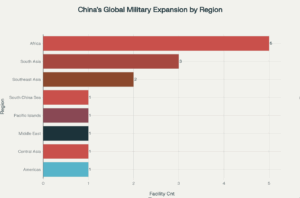China’s Growing Military Presence Around the World
China’s military expansion represents one of the most significant developments in
contemporary international security, fundamentally transforming Beijing from a regionally
focused power to a global military presence. Over the past decade, the People’s Liberation
Army (PLA) has achieved unprecedented power-projection capabilities through established
military bases, dual-use facilities, and strategic partnerships that extend across multiple
continents.
Established Military Bases Outside China
Djibouti Naval Support Base – China’s Strategic Gateway
China’s first overseas military base became operational in Djibouti on August 1, 2017, marking a watershed moment in Chinese military history. Constructed at a cost of $590 million, this facility serves multiple strategic functions beyond its stated anti-piracy mission, housing up to two brigades of PLA forces with comprehensive military infrastructure including barracks, underground facilities, helicopter hangars, and a 330-meter pier capable of accommodating large naval vessels.
Strategically positioned at the entrance to the Red Sea near the Bab-el-Mandeb Strait, the base provides China with critical oversight of maritime traffic. Approximately $1 billion worth of Chinese goods transit through this strategic waterway daily, while 47% of China’s imported oil from the Middle East passes through the strait. The facility’s location adjacent to le Chinese-operated Port of Doraleh amplifies its dual-use potential, enabling both commercial and military operations.
Cambodia’s Ream Naval Base – Southeast Asian Foothold
China’s second publicly acknowledged overseas military facility became operational in April 2025 at Cambodia’s Ream Naval Base. The China-Cambodia Joint Logistics and Training Center features extensive Chinese-funded infrastructure including a 300-meter deep-water pier, a 5,000-ton dry dock, and comprehensive training facilities.
Chinese Type-056A corvettes have maintained a permanent presence at the base since December 2023. Strategically positioned near Sihanoukville on Cambodia’s Gulf of Thailand coast, the base provides China with critical access to the South China Sea and proximity to
the vital Malacca Strait. Despite Cambodian government denials about exclusive Chinese military use, the facility enables China to project power throughout Southeast Asia while potentially monitoring regional maritime traffic.
Fortified Artificial Islands and Maritime Installations South China Sea – The “Great Wall of Sand”
China has undertaken the most extensive artificial island construction program in modern history, creating over 3,200 hectares of militarized territory across the South China Sea.
Between 2013 and 2017, China constructed seven major artificial islands in the Spratly Islands, transforming underwater reefs into fully operational military bases.
The three largest installations – Fiery Cross Reef, Mischief Reef, and Subi Reef – feature 3,000-meter runways capable of supporting military aircraft including fighter jets and strategic bombers. These facilities house over 72 fighter jet hangars, surface-to-air missile systems, anti-ship cruise missiles, and comprehensive radar and communications infrastructure.
Recent satellite imagery confirms the deployment of China’s most advanced H-6 bombers to Woody Island in the Paracel Islands, marking the first such deployment since 2020 and demonstrating enhanced long-range strike capabilities. These installations effectively extend China’s military reach over 700 miles from its mainland bases, creating what experts describe as unsinkable aircraft carriers in disputed waters.
Dual-Use Facilities and Strategic Partnerships
Pakistan’s Gwadar Port – Strategic Arabian Sea Access
Gwadar Port represents perhaps the most significant dual-use facility in China’s global military expansion strategy. Located on Pakistan’s Balochistan coast near the Strait of Hormuz, this deep-water port is owned and operated by China Overseas Port Holding Company under a 43-year lease arrangement.
The port’s strategic significance extends beyond commercial operations, providing China with direct access to the Arabian Sea while reducing energy import routes from 12,000 kilometers to approximately 6,500 kilometers. Chinese investment in Gwadar totals over $1.15 billion, including construction of military-grade infrastructure with deep-water berths capable of accommodating large naval vessels.
Recent reports indicate Pakistan has privately offered China the option to establish a military base at Gwadar, though this remains under negotiation as Pakistan seeks to leverage this concession for debt restructuring and military assistance.
Tajikistan Military Outposts – Central Asian Security
China operates at least two military facilities in Tajikistan’s remote Gorno-Badakhshan region, representing its expanding presence in Central Asia. Constructed following China’s 2016 security pact with Tajikistan, these facilities officially serve counter-terrorism and border security functions related to the unstable situation in neighboring Afghanistan.
The installations are staffed by China’s People’s Armed Police rather than regular military forces, reflecting their quasi-military nature. China has committed to funding additional border infrastructure and has reportedly offered to assume full operational control of these facilities in exchange for military aid.
China’s Global Port Network and Strategic Expansion
China’s global commercial port network encompasses over 100 ports across 53 countries, creating an unprecedented platform for potential military operations. Chinese firms own or operate terminal assets at strategically located facilities including Piraeus in Greece, Hambantota in Sri Lanka, and various ports across Africa and Latin America.
Under Chinese law, all overseas infrastructure must be built to military standards, while Chinese companies are legally obligated to provide access to military forces when required.
This civil-military fusion strategy creates a global network of facilities that can theoretically support PLA operations during peacetime or conflict.
Security Agreements and Pacific Expansion
Solomon Islands Security Agreement
China’s security agreement with the Solomon Islands, signed in April 2022, represents Beijing’s first known bilateral security arrangement in the Pacific. The agreement permits deployment of Chinese “police, armed police, military personnel and other law enforcement forces” to assist in maintaining social order and providing humanitarian aid.
Located just 1,200 nautical miles from Australia, the Solomon Islands provides China with potential access to critical Pacific shipping lanes. While no military base currently exists, the agreement creates the framework for future Chinese military presence in a region traditionally dominated by U.S. and Australian influence.
Regional and Global Implications
China’s security agreement with the Solomon Islands, signed in April 2022, represents Beijing’s first known bilateral security arrangement in the Pacific. The agreement permits deployment of Chinese “police, armed police, military personnel and other law enforcement forces” to assist in maintaining social order and providing humanitarian aid.
Located just 1,200 nautical miles from Australia, the Solomon Islands provides China with potential access to critical Pacific shipping lanes. While no military base currently exists, the agreement creates the framework for future Chinese military presence in a region traditionally dominated by U.S. and Australian influence.
Regional and Global Implications
Pentagon Projections and Future Expansion
U.S. intelligence assessments identify numerous additional countries where China is pursuing military facilities, including Cuba, Equatorial Guinea, Myanmar, Pakistan, Sri Lanka, Tanzania, and the United Arab Emirates. The Pentagon projects that China seeks to establish at least five overseas bases and ten logistics support sites by 2030 as part of “Project 141”.
Recent leaked intelligence documents reference China’s goal to “establish at least 5 overseas bases and 10 logistic support sites by 2030 to fulfill Beijing’s national security objectives”. This expansion would provide China with the foundation for sustained military objectives” operations far from its borders, fundamentally altering global military balance.
Africa as a Testing Ground
China’s military engagement in Africa has expanded significantly, with the PLA conducting 19 military exercises, 44 naval port calls, and 276 senior defense exchanges across the continent since 2000. The recent Peace Unity-2024 exercise in Tanzania involved over 1,000 Chinese troops deployed by sea and air, representing China’s largest-ever military exercise in Africa.
During the September 2024 Forum on China-Africa Cooperation summit, Beijing pledged 50 billion over three years to Africa, with $140 million dedicated specifically to security cooperation, including training for 6,000 military personnel and 1,000 law enforcement officers.
Bar chart showing the regional distribution of China’s overseas military facilities and strategic partnerships
The regional distribution of China’s military expansion shows a clear focus on strategic maritime chokepoints and economic corridors. Africa leads with five installations, reflecting
China’s emphasis on protecting sea lines of communication through the Indian Ocean and Red Sea. South Asia follows with three facilities, centered on the critical Arabian Sea and Bay of Bengal regions.
Strategic Assessment and Future Outlook
China’s global military expansion serves multiple strategic objectives including protecting expanding economic interests, securing critical sea lines of communication, and challenging the established international order dominated by Western military presence. The combination of established bases in Djibouti and Cambodia, fortified artificial islands in the South China Sea, dual-use facilities like Gwadar Port, and expanding security partnerships creates an integrated network capable of supporting sustained military operations across multiple theaters.
Pentagon assessments indicate China’s determination to achieve peer competitor status with the United States by 2027, with the capability to protect its interests and project influence on a global scale. The Pentagon’s 2024 China Military Power Report notes that China now possesses over 600 operational nuclear warheads and the world’s largest navy with 370 ships and submarines, projected to reach 435 ships by 2030.
Despite ongoing challenges including endemic corruption within the PLA and economic headwinds, China’s military modernization continues at an unprecedented pace. As China develops its expeditionary capabilities and expands its overseas footprint, the implications for regional stability and global security will only continue to grow, fundamentally reshaping the strategic calculus for nations worldwide.

